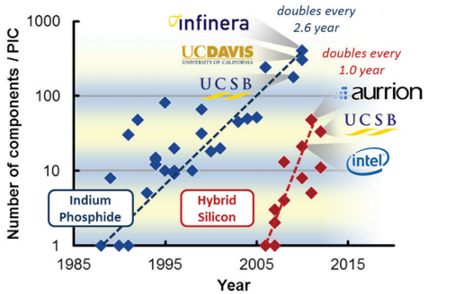Silicon Photonics: Present & Future Perspective at IPR
Silicon Photonics: Present & Future Perspective at IPR
Shamsul Arafin
III-V/silicon hybrid lasers, silicon-itself lasers and III-V/silicon photonic integrated circuits (PIC) - in general, silicon photonics is the research area moving forward at a great speed over the last couple of years. Why such a great speed? Because a number of ever-demanding applications like optical interconnects, long haul communication systems, and conventional CMOS technology need added bandwidth, which could be easily realized by this growing research area. In addition, currently researchers are thinking about the integration of the silicon laser into chips that could be used for medical and security applications.
Taking this fact into account, this year Integrated Photonics Research, Silicon, and Nano-Photonics (IPR) meeting at OSA's Advanced Photonics Congress will cover a number of invited talks by leading researchers and scholars from industry and academia in this field.
For instance, Dr. Alban Leliepvre from Alcatel-Thales III-V Laboratory, France, will give a comprehensive talk on III-V/IV hybrid lasers in IPR meeting. Hope he will present some ground-breaking results including the use of the III-V on silicon platform for the realization of tunable single wavelength lasers with 8 nm tuning range. Moreover, he will show the very latest results on the realization of high speed silicon modulators through an integration of these lasers. Wow! Isn’t that fascinating? Such a laser structure can certainly become an important device for future telecommunication and data communication systems.
Prof. Gunther Roelkens from Universiteit Gent, Belgium will make the scenario of silicon photonics research further clear in the same meeting by showing some excellent results what he and their research collaborators has currently achieved in this field. Hope he will bring some fresh exciting results which include but not limited to, a hybrid evanescently coupled long-wavelength III–V/silicon distributed-feedback (DFB) laser with an integrated monitor photodiode. Researchers all around the world are really keen to see how his research group came up with such magnificent results. Special thanks to the IPR meeting at OSA's Advanced Photonics Congress for creating such an opportunity.
Furthermore, some leading experts from the industry will share their views at the meeting to demonstrate the current research trends as well as their latest accomplishments in silicon photonics. In fact, there is a huge competition between academia and industry in this field as shown in the below chart. This chart also shows the competition between two different existing technologies to integrate several photonic components onto chips. The complexity of indium phosphide (InP) and hybrid silicon chip is measured as the number of components per chip. Without a doubt, InP-based monolithic integration has increased in complexity exponentially over the past two decades, but according to the researchers, hybrid silicon PICs are catching up and fast. I hope that these issues on silicon photonics research will be highlighted in IPR meeting. This will certainly motivate the researchers to move the research progress further forward.

Photo credit:
http://www.compoundsemiconductor.net/csc/adminpanel/uploads/magazine_images/CSApril_May2013.pdf
MK Smit, JJGM. van der Tol, and MT Hill, “Moore’s law in photonics,” Laser Photon. 6 1, 2012
MJR Heck et al; “Hybrid Silicon Photonic Integrated Circuit Technology” JSTQE 19 4, 2013
